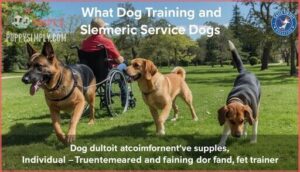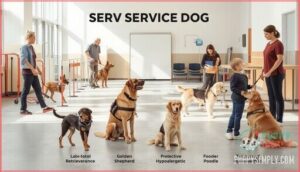This site is supported by our readers. We may earn a commission, at no cost to you, if you purchase through links.

The catch? These same dogs rank 72nd out of 79 breeds in obedience tests, needing up to 100 repetitions to master commands that other breeds learn in five. This creates a fascinating contradiction—remarkable detection abilities paired with stubborn independence.
Whether a Beagle can succeed as your service dog depends on matching their unique strengths to specific tasks, understanding their limitations, and knowing which disabilities they’re genuinely equipped to support.
Table Of Contents
- Key Takeaways
- What Makes a Good Service Dog?
- Are Beagles Smart and Trainable Enough?
- What Tasks Can a Beagle Service Dog Perform?
- Are Beagles Reliable Off-Leash?
- What Disabilities Can a Beagle Assist With?
- Can Any Dog Be a Service Dog?
- Service Dog Training Considerations
- Laws and Regulations for Service Dogs
- Finding The Right Service Dog
- Frequently Asked Questions (FAQs)
- What are the qualities of Beagles as dogs?
- Are Beagles good search and rescue dogs?
- Are Beagles sociable dogs?
- What does a beagle dog look like?
- What is the cost of acquiring and training a beagle service dog?
- How do I get my beagle certified as an official service dog?
- What are some challenges or disadvantages to having a beagle as a service dog?
- How much does a beagle service dog cost?
- What is a beagles average lifespan?
- Do beagles have common health problems?
- Conclusion
Key Takeaways
- Beagles possess exceptional scent detection abilities with 220 million scent receptors, making them highly effective for medical alert tasks like detecting blood sugar changes, seizures, and panic attacks—but their stubborn independence (ranked 72nd out of 79 breeds in obedience) means they require 80-100 repetitions to learn commands compared to top breeds that learn in five.
- Their compact size (20-30 pounds) and strong scent drive make Beagles ideal for retrieval tasks, psychiatric support, and specific medical alerts, but they’re unsuitable for mobility assistance, weight-bearing support, or tasks requiring reliable off-leash behavior due to their hunting instincts overriding recall commands.
- Success with a Beagle service dog depends entirely on matching their natural strengths to your specific disability—they excel at scent-based detection work and emotional grounding but struggle with sustained focus, off-leash reliability, and tasks requiring instant obedience in distracting environments.
- Training a Beagle for service work costs $15,000-$50,000 and takes 18-30 months using short, food-motivated sessions, with no federal certification required under ADA law—what matters is that the dog performs disability-related tasks and behaves appropriately in public settings.
What Makes a Good Service Dog?
When you’re choosing a service dog, temperament stability becomes your foundation. A calm, even-keeled dog with low reactivity and high sociability shows a 93% success rate in initial aptitude tests—because hyperactive or anxious dogs often struggle with the unpredictable nature of public work.
Intelligence and trainability matter just as much, accounting for over 60% of a dog’s readiness for service tasks. Dogs with strong problem-solving skills and cognitive flexibility adapt twice as fast to complex commands, making them reliable partners in real-world situations.
Physical health can’t be overlooked either. Dogs with musculoskeletal issues face 50% higher dropout rates, which is why thorough health screening is essential.
Early socialization skills boost adaptability by 45%, helping your dog navigate crowded stores, noisy streets, and unfamiliar spaces with confidence.
Are Beagles Smart and Trainable Enough?
Here’s the truth about Beagles and intelligence: they’re ranked 72nd out of 79 breeds in obedience tests, but that doesn’t tell the whole story. Your Beagle isn’t "dumb"—they just think differently.
Beagles possess around 220 million scent receptors, making their olfactory cognition exceptional. That’s what drives their behavior. When a Beagle seems distracted, they’re actually processing thousands of scent messages you can’t even detect. Their scent motivation is so powerful it can delay command response by 3–4 seconds.
Learning speed requires patience. Beagles need 80–100 repetitions to master new commands, compared to top breeds that learn in under five tries. But here’s what matters for service work: their task persistence ranks in the top 30% of all breeds. Once trained, they retain skills as well as higher-ranked dogs.
Their cognitive strengths shine in food-motivated training, boosting obedience success by 40%. Short sessions under 20 minutes work best. With 10 weeks of consistent reinforcement, your Beagle can achieve reliable command recall—proving Beagle trainability succeeds through understanding, not force. Despite their ranking, Beagles show high levels of instinctive intelligence.
What Tasks Can a Beagle Service Dog Perform?
Beagles aren’t just cute faces with floppy ears—they can actually perform some pretty impressive service dog tasks. Their natural abilities, especially that legendary nose, open doors to specific types of work that play to their strengths.
Let’s look at three key tasks where beagles really shine as service dogs.
Retrieval
What makes retrieval work so well for beagles as a service dog? Their compact size and eagerness to please turn them into reliable helpers for your daily physical tasks. During training lasting 120–200 hours, beagles master identifying and retrieving over 20 named objects with impressive accuracy rates hovering around 92%.
Here’s what your beagle can fetch when you need assistance:
- Lightweight essentials – phones, medication bottles, wallets, or keys (up to 1.5 kg)
- Emergency delivery items – first aid kits, medical alert devices, or communication tools
- Assistive devices – canes, dropped mobility aids, or button activation for emergency systems
Object identification becomes second nature through consistent practice and positive reinforcement, making retrieving assistive tasks a beagle’s specialty.
Alerting
Beyond fetching items, your beagle service dog excels at alerting you to critical changes you might miss. With approximately 220 million scent receptors, beagles detect medical shifts with impressive precision.
Trained alert dogs recognize volatile organic compounds linked to low blood sugar episodes, warning diabetic handlers before dangerous dips occur. Through scent detection and sound recognition, they’ll notify you of smoke alarms, doorbells, or approaching hazards.
Emergency response training teaches beagles to signal pre-seizure biochemical changes minutes before onset, giving you time to prepare. Their natural alert reliability stems from behavior cues they pick up instinctively, though consistent reinforcement keeps them focused despite their curious nature. That’s why positive training methods work best for channeling their outstanding nose into life-saving alerts.
Psychiatric Support
When panic strikes or depression weighs heavy, your beagle can step in with real support. Deep Pressure Therapy (DPT) techniques use their body weight—around 20 to 30 pounds—to calm anxiety and ground you during PTSD episodes.
They’re trained to interrupt dissociation through tactile grounding, pawing or nudging you back to the present moment. Beagles excel at emotional reinforcement, offering companionship that eases social withdrawal and lifts your mood.
They’ll even wake you from nightmares or alert you during panic attacks, helping you regain control when mental health challenges feel overwhelming.
Are Beagles Reliable Off-Leash?
Why do beagles struggle so much when they’re off-leash? Their noses tell the story—with around 220 million scent receptors, beagles rank among the most scent-driven breeds. Once they catch a trail, recall commands often vanish into thin air. That hunting instinct doesn’t just fade with training.
Here’s what you’re up against with beagle service dog training:
- Scent distraction overrides everything: Their sense of smell is about 1,000 times stronger than yours, and environmental factors constantly compete for their attention
- Escape risks run high: Beagles frequently dig under or scale 4-foot fences when following interesting scents
- Breed tendencies favor independence: They consistently rank in the bottom 10 for recall reliability among over 100 breeds
- Training consistency takes time: Even with positive reinforcement, achieving reliable off-leash obedience usually requires a year or more
For service work requiring off-leash reliability in public spaces, beagles present significant challenges despite their other working capabilities.
What Disabilities Can a Beagle Assist With?
Beagles aren’t a one-size-fits-all solution, but they can make a real difference for people facing specific challenges. Their strengths align well with certain disabilities while falling short for others.
Let’s look at the three main areas where beagles can step up and serve.
Mobility Issues
When it comes to limited mobility, Beagles can lend a helping paw—but only for lightweight tasks. Their compact size (20–30 pounds) means they won’t provide weight-bearing support or balance assistance like larger breeds. Instead, they excel at retrieval work: fetching keys, medication, or small tools. They can also activate accessible push buttons and navigate crowded spaces to guide you safely.
Here’s what Beagle service dog potential looks like for physical disabilities:
| Task Type | Beagle Capability | Best For |
|---|---|---|
| Retrieval | Excellent for small items | Independence facilitation |
| Environmental navigation | Strong in tight spaces | Crowded public areas |
| Weight-bearing support | Not suitable | Requires larger breeds |
Research shows service dogs performing mobility-related assistance greatly improve handlers’ social and work functioning. While Beagles won’t replace a traditional mobility assistance dog, they offer real support for those needing light help. Consult an experienced trainer to determine if a Beagle fits your specific needs.
Medical Conditions
Think of a Beagle’s nose as a biological alarm system—those 220 million odor receptors can detect hypoglycemia in diabetic handlers before your blood sugar drops too low. Your Beagle picks up on breath or sweat changes that signal trouble ahead. They’re also reliable for seizure alerts, sensing subtle shifts in body chemistry before epilepsy episodes begin. This gives you critical time for medication assistance or emergency response.
About 34% of service dogs focus on medical alert tasks, and Beagles excel here thanks to their scent detection abilities. With proper condition monitoring training, they help you maintain independence while managing diabetes, epilepsy, or allergy detection—though genetic predispositions like their own epilepsy (2–3% of Beagles) require careful veterinary maintenance throughout their service years.
Psychiatric Disorders
When your anxiety feels like a tidal wave, your Beagle can become a steady anchor. Nearly 45% of service dog handlers rely on psychiatric support for conditions like PTSD, anxiety, and depression.
Your Beagle provides emotional grounding through behavior interruption—nudging or pawing to stop harmful patterns—and deep pressure therapy during panic attacks. Their calm presence reduces symptom severity, offering you safety and stability when mental health challenges feel overwhelming.
Can Any Dog Be a Service Dog?
Technically, yes—the ADA doesn’t impose breed restrictions or size limitations on service dogs. If your dog can perform disability-related tasks and behave appropriately in public, any breed qualifies. That said, temperament concerns and training capacity matter more than breed alone. Not every dog has what it takes, even if the law allows it.
Here’s what you need to know about dog breed suitability:
- Essential traits for service dogs include focus, calmness under pressure, and a willingness to work closely with you
- Task suitability varies—small breeds excel at medical alerts, while larger dogs handle mobility support
- Beagle characteristics like their strong nose make them great for detection work but can be challenging for tasks requiring sustained focus
- Training capacity depends on the individual dog’s temperament, not just breed stereotypes
The key isn’t whether a breed can legally serve—it’s whether your specific dog has the right temperament and abilities for your needs.
Service Dog Training Considerations
Training a service dog isn’t something you can wing—it takes the right candidate, the right approach, and a clear understanding of what the job demands. Not every dog has what it takes, and even breeds with potential need careful evaluation and structured guidance.
Let’s break down what you should consider when preparing a dog for service work.
Qualities of Good Prospects
You need essential traits for service dogs to click before diving into training. A calm temperament stands out as the foundation—behavioral instability causes over 70% of training failures. Strong cognitive abilities matter too, predicting success in 86% of working dog candidates.
Physical health, especially hip and elbow integrity, keeps dogs working safely. Work drive fuels motivation and task reliability. Don’t overlook genetic factors either, as stable temperament passes down through generations.
For Beagles specifically, their intelligence and loyalty shine, but you’ll want to assess each dog’s individual Beagle characteristics against these benchmarks.
Choosing Appropriate Breeds
You’ve identified strong candidates—now let’s talk about breed selection. Breed temperament plays a massive role here because consistency matters when lives depend on it. Labradors and Golden Retrievers lead with over 85% training success rates, while German Shepherds tackle physically demanding roles with 80%+ completion rates. Poodles and their mixes suit handlers with allergies, covering 60% of allergy-sensitive placements.
Size matters more than you’d think. Your handler’s living space, strength, and mobility needs should guide your choice. Beagles weigh 20–30 pounds—perfect for compact homes and psychiatric support—but larger breeds handle heavy mobility work better.
Here’s what drives smart breed selection:
- Breed temperament: Calm, stable personalities reduce reactivity
- Breed health: Low dysplasia rates extend working years
- Handler lifestyle: Energy levels must match daily routines
- Breed purpose: Match natural instincts to required tasks
- Dog breed suitability: Assess individual traits, not just breed averages
Beagle service dogs excel in scent detection and emotional support, but represent under 10% of certifications due to shorter focus spans compared to retrievers.
Effective Training Strategies
Beagle service dogs thrive when you apply positive reinforcement—food rewards work wonders with their scent-driven brains. Research shows that training frequency matters: weekly sessions outperform daily ones for retention.
Here’s your game plan:
- Use 5–10 minute sessions 2–3 times daily to prevent frustration
- Incorporate scent work to sharpen focus and inhibitory control
- Practice handler consistency across all environments and commands
Shaping behavior step-by-step builds complex skills like medical alerts, while task-specific training gets them ready for real-world service demands over 18–30 months.
Laws and Regulations for Service Dogs
Once you understand your dog’s training potential, you’ll want to know what legal protections come with service dog status. The Americans with Disabilities Act (ADA) defines service animals as dogs individually trained to perform tasks for people with disabilities. Under ADA regulations, your service dog can accompany you in all public places—restaurants, stores, hotels, and more.
Businesses can only ask two questions: whether your dog is required for a disability and what tasks it performs. They can’t demand documentation or certification because no federal system exists for service dog legal requirements. However, your dog must stay under control, and businesses can remove animals that are disruptive or not housebroken.
Housing rights under the Fair Housing Act mean landlords must allow your service dog even in no-pet buildings, without charging pet fees. For air travel, airlines require DOT forms and only recognize task-trained service dogs—emotional support animals lost flight access in 2021. State laws increasingly penalize people who falsely claim pets as service animals, with fines often exceeding $500.
| Legal Area | Protection Type | Key Requirement |
|---|---|---|
| Public Access | ADA Titles II & III | Dog must be task-trained and under control |
| Housing Rights | Fair Housing Act | Reasonable accommodation, no pet fees |
| Travel Rules | DOT Air Travel | Health form required; ESAs excluded |
| State Laws | Misrepresentation | Fines up to $1,000 for false claims |
| Workplace | ADA Compliance | Access granted unless causing undue disruption |
Finding The Right Service Dog
After understanding legal protections, your next step involves selecting a dog that truly matches your needs. Program Accreditation ensures you’re working with reputable organizations—look for groups certified by Assistance Dogs International or similar bodies that follow standardized training protocols.
The Matching Process usually spans three to six months and emphasizes Handler Needs like your lifestyle, disability type, and energy levels. While Beagles offer unique strengths, exploring Breed Alternatives helps you find the best fit:
- Labrador Retrievers excel in mobility and retrieval tasks with calm, reliable temperaments
- Golden Retrievers provide gentle psychiatric support and adaptable public behavior
- German Shepherds handle complex alerts and protection work effectively
- Poodles suit allergy concerns while maintaining high trainability across service roles
- Custom matches through Temperament Testing identify individual dogs whose personalities align with your specific requirements
Service dogs demonstrate task reliability above 85% and obedience consistency over 90% across environments. Programs assess dog breed suitability and dog breed characteristics through multistage evaluations, ensuring your partner succeeds long-term.
Frequently Asked Questions (FAQs)
What are the qualities of Beagles as dogs?
You might think beagles are too stubborn to follow direction, but their merry temperament and low aggression rate tell a different story.
Originally bred as pack hounds, they’re friendly with people and animals alike, making them manageable companions at 18–35 pounds.
Are Beagles good search and rescue dogs?
Yes, Beagles can excel in search and rescue work thanks to their outstanding scent tracking abilities—with around 300 million olfactory receptors, they can follow trails for days. Their stamina and weather-resistant coat support endurance in demanding conditions.
However, their short attention span means training duration often extends six months to a year, requiring consistent distraction management to overcome breed limitations.
Are Beagles sociable dogs?
Beagles are naturally sociable dogs that bond easily with humans and other dogs. Research shows their human sociability is rooted in genetic factors, and early socialization strengthens their friendly temperament, reducing fear and improving behavioral traits through positive dog interactions.
What does a beagle dog look like?
Like a soft velvet bookmark tucked into your favorite story, a beagle’s floppy ears frame their expressive brown or hazel eyes and gentle, pleading face.
This dog breed features a slightly domed skull, square muzzle, and compact, muscular build weighing 20-30 pounds.
What is the cost of acquiring and training a beagle service dog?
A fully trained beagle service dog generally costs $15,000 to $30,000 from professional training programs. You’ll face annual upkeep costs of $2,000 to $3,500 for food, veterinary care, grooming, and equipment replacements.
Financial assistance through nonprofit grants and VA programs can help offset these expenses.
How do I get my beagle certified as an official service dog?
Here’s the truth: no federal law requires service dog certification. Under the ADA requirements, you can owner-train your Beagle without any official paperwork.
What matters is that your dog performs specific disability-related tasks and behaves appropriately in public access settings. Training programs help, but legal certification doesn’t exist.
What are some challenges or disadvantages to having a beagle as a service dog?
While beagles bring warmth and energy to any partnership, their breed characteristics can create real hurdles. Their powerful noses lead to scent distraction that derails focus during critical tasks. Vocalization issues like persistent baying can disrupt quiet environments.
Training difficulty emerges from their independent streak, requiring 18-24 months of public access work—much longer than other breeds. Physical limitations restrict mobility support since they weigh only 20-30 pounds. Their strong prey drive makes off-leash reliability challenging, especially around small animals or sudden movements.
How much does a beagle service dog cost?
A fully trained Beagle service dog generally costs between $15,000 and $50,000, depending on specialization. Initial Beagle cost runs $710 to $1,200, while training cost breakdown varies from under $1,000 for owner-assisted programs to $30,000+ for professional certification.
Annual upkeep expenses average $1,000 to $2,300 for food, vet care, and supplies.
What is a beagles average lifespan?
Most healthy beagles live between 12 and 15 years, with many reaching their early teens. Genetic factors, diet impact, and exercise benefits all play a role in longevity.
Common health issues like obesity, cancer, and hypothyroidism can shorten their lifespan if not managed properly.
Do beagles have common health problems?
Yes, beagles face several health issues. Obesity affects nearly 24% of the breed, while periodontal disease impacts around 18%. Ear infections occur in 6-11% due to their floppy ears.
Hip dysplasia and epilepsy risks also exist, with genetic predisposition playing a role.
Conclusion
Beagles can succeed as service dogs, but only when their remarkable noses meet the right need. Beagles excel at scent-based medical alerts—not mobility support or psychiatric grounding.
They thrive detecting blood sugar crashes and seizures—not off-leash reliability or instant obedience. If you’re asking "are beagles good service dogs," the honest answer lives in the middle: their stubborn independence becomes irrelevant when their natural talents align perfectly with your disability.
Match the dog to the task, commit to patient training, and that zigzagging hound might just save your life.
















